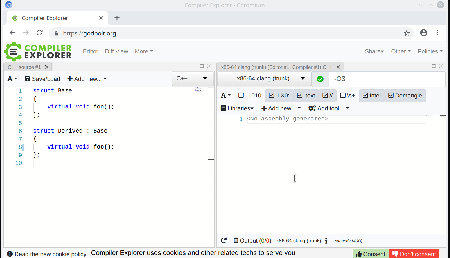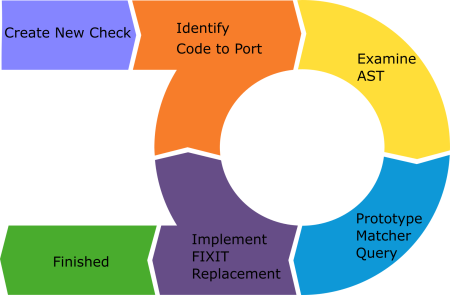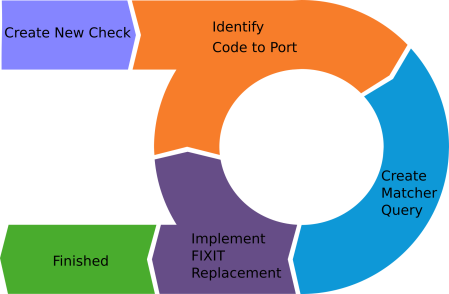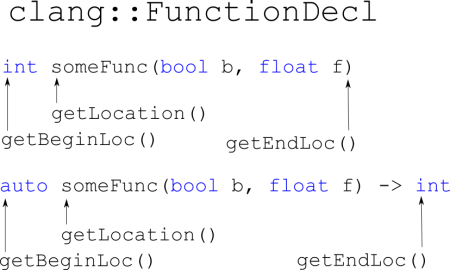Getting started – clang-tidy AST Matchers
Over the last few weeks I published some blogs on the Visual C++ blog about Clang AST Matchers. The series can be found here:
I am not aware of any similar series existing which covers creation of clang-tidy checks, and use of clang-query to inspect the Clang AST and assist in the construction of AST Matcher expressions. I hope the series is useful to anyone attempting to write clang-tidy checks. Several people have reported to me that they have previously tried and failed to create clang-tidy extensions, due to various issues, including lack of information tying it all together.
Other issues with clang-tidy include the fact that it relies on the “mental model” a compiler has of C++ source code, which might differ from the “mental model” of regular C++ developers. The compiler needs to have a very exact representation of the code, and needs to have a consistent design for the class hierarchy representing each standard-required feature. This leads to many classes and class hierarchies, and a difficulty in discovering what is relevant to a particular problem to be solved.
I noted several problems in those blog posts, namely:
- clang-query does not show AST dumps and diagnostics at the same time<
- Code completion does not work with clang-query on Windows
- AST Matchers which are appropriate to use in contexts are difficult to discover
- There is no tooling available to assist in discovery of source locations of AST nodes
Last week at code::dive in Wroclaw, I demonstrated tooling solutions to all of these problems. I look forward to video of that talk (and videos from the rest of the conference!) becoming available.
Meanwhile, I’ll publish some blog posts here showing the same new features in clang-query and clang-tidy.
clang-query in Compiler Explorer
Recent work by the Compiler Explorer maintainers adds the possibility to use source code tooling with the website. The compiler explorer contains new entries in a menu to enable a clang-tidy pane.

clang-tidy in Compiler Explorer
I demonstrated use of compiler explorer to use the clang-query tool at the code::dive conference, building upon the recent work by the compiler explorer developers. This feature will get upstream in time, but can be used with my own AWS instance for now. This is suitable for exploration of the effect that changing source code has on match results, and orthogonally, the effect that changing the AST Matcher has on the match results. It is also accessible via ce.steveire.com.
It is important to remember that Compiler Explorer is running clang-query in script mode, so it can process multiple let and match calls for example. The new command set print-matcher true helps distinguish the output from the matcher which causes the output. The help command is also available with listing of the new features.
The issue of clang-query not printing both diagnostic information and AST information at the same time means that users of the tool need to alternate between writing
set output diag
and
set output dump
to access the different content. Recently, I committed a change to make it possible to enable both output and diag output from clang-query at the same time. New commands follow the same structure as the set output command:
enable output detailed-ast disable output detailed-ast
The set output command remains as an “exclusive” setting to enable only one output feature and disable all others.
Dumping possible AST Matchers
This command design also enables the possibility of extending the features which clang-query can output. Up to now, developers of clang-tidy extensions had to inspect the AST corresponding to their source code using clang-query and then use that understanding of the AST to create an AST Matcher expression.

That mapping to and from the AST “mental model” is not necessary. New features I am in the process of upstreaming to clang-query enable the output of AST Matchers which may be used with existing bound AST nodes. The command
enable output matcher
causes clang-query to print out all matcher expressions which can be combined with the bound node. This cuts out the requirement to dump the AST in such cases.

Inspecting the AST is still useful as a technique to discover possible AST Matchers and how they correspond to source code. For example if the functionDecl() matcher is already known and understood, it can be dumped to see that function calls are represented by the CallExpr in the Clang AST. Using the callExpr() AST Matcher and dumping possible matchers to use with it leads to the discovery that callee(functionDecl()) can be used to determine particulars of the function being called. Such discoveries are not possible by only reading AST output of clang-query.
Dumping possible Source Locations
The other important discovery space in creation of clang-tidy extensions is that of Source Locations and Source Ranges. Developers creating extensions must currently rely on the documentation of the Clang AST to discover available source locations which might be relevant. Usually though, developers have the opposite problem. They have source code, and they want to know how to access a source location from the AST node which corresponds semantically to that line and column in the source.
It is important to make use a semantically relevant source location in order to make reliable tools which refactor at scale and without human intervention. For example, a cursory inspection of the locations available from a FunctionDecl AST node might lead to the belief that the return type is available at the getBeginLoc() of the node.
However, this is immediately challenged by the C++11 trailing return type feature, where the actual return type is located at the end. For a semanticallly correct location, you must currently use
getTypeSourceInfo()->getTypeLoc().getAs().getReturnLoc().getBeginLoc()
It should be possible to use getReturnTypeSourceRange(), but a bug in clang prevents that as it does not appreciate the trailing return types feature.

Once again, my new output feature of clang-query presents a solution to this discovery problem. The command
enable output srcloc
causes clang-query to output the source locations by accessor and caret corresponding to the source code for each of the bound nodes. By inspecting that output, developers of clang-tidy extensions can discover the correct expression (usually via the clang::TypeLoc heirarchy) corresponding to the source code location they are interested in refactoring.
Next Steps
I have made many more modifications to clang-query which I am in the process of upstreaming. My Compiler explorer instance is listed as the ‘clang-query-future’ tool, while the clang-query-trunk tool runs the current trunk version of clang-query. Both can be enabled for side-by-side comparison of the future clang-query with the exising one.
November 12, 2018 at 11:02 am |
[…] Future Developments in clang-query […]
December 10, 2018 at 6:07 pm |
This is great content and is similar to the presentation I gave at C++Now! 2014: https://github.com/boostcon/cppnow_presentations_2014/blob/master/files/Create-Your-Own-Refactoring-Tool-with-Clang.pdf
January 2, 2019 at 9:57 pm |
[…] wrote about the AST-Matcher and Source Location/Source Range discovery features on my blog here since delivering the talk. I also wrote about Composing AST Matchers, which was part of the tips […]
April 16, 2019 at 8:29 am |
[…] of the workflow of using AST Matchers is an iterative development process. For example, the developer wishes to find functions of a […]
July 10, 2019 at 2:50 pm |
I am interested in how do you get colored output in the CE. Do you modify the code of clang-query?
July 10, 2019 at 7:48 pm |
Yes, that’s part of what I’ll attempt to upstream 🙂
December 15, 2019 at 4:38 pm |
Hi Steve, I just watched your video and was trying clang-query, but it failed to complete on windows and “enable output matcher” didn’t exists. This is with LLVM 9.0.0. Am I doing something wrong, or are your changes not yet upstream?
December 18, 2019 at 8:46 pm |
Hi Jesper, the changes are not upstream yet I’m afraid! Working on that now that this Grantlee release is done :).
April 28, 2022 at 2:54 pm
Great stuff!
Has “enable output matcher” been made available somewhere yet?
May 18, 2022 at 12:44 pm
I’m afraid not. I only made a proof of concept and I’m not putting time into contributing to clang anymore.
March 11, 2021 at 11:19 am |
Earth energy present
Future Developments in clang-query | Steveire's Blog
April 27, 2021 at 9:08 am |
[…] for experimentation in Compiler Explorer. I previously delivered a talk at EuroLLVM 2019 and blogged in 2018 about this feature and others to assist in discovery of AST matchers and source locations. This is […]
June 13, 2021 at 12:56 am |
wyndham là gì
Future Developments in clang-query | Steveire's Blog
June 20, 2021 at 7:41 am |
Dad Coinmarketcap
Future Developments in clang-query | Steveire's Blog
June 26, 2021 at 4:29 am |
https://Otomotozlot.Pl
Future Developments in clang-query | Steveire's Blog
August 24, 2021 at 1:07 pm |
Keywords
Future Developments in clang-query | Steveire's Blog